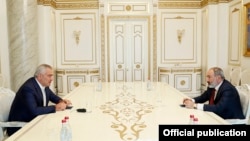The company, Electric Networks of Armenia (ENA), said many accidents causing them result from sloppy roadworks and a construction boom in Yerevan that has sharply increased the number of its service subscribers. It also put the blame on some Armenian power plants as well as the national power transmission network.
The outages that can last for several hours are now a regular occurrence in the Armenian capital. They gained more public resonance last month after disrupting a Russian ballet performance in the city’s Opera House and interrupting an international football game in the nearby town of Abovian. This fueled more calls for the Armenian government to tackle the problem and investigate ENA.
The ENA chairman, Karen Darbinian, denied responsibility for either embarrassing incident. In his words, the Opera House management ignored ENA’s prior warning to replace an aging electric transformer belonging to the state theater. He also criticized the Football Federation of Armenia, saying that it had deactivated one of the Abovian stadium’s two transformers for cost-cutting purposes months before the European Conference League match.
“Out of 1,456 [power cuts this year,] 492 were caused by other organizations,” Darbinian told a news conference. “We had to repair cables to restore power supplies to the population.”
Darbinian said the cables are routinely damaged by workers paving streets or laying new water and gas pipes. He said his company has also found itself under greater strain because of having to supply power to 68,000 new households in Yerevan. They live in new apartment blocks built in recent years. In Darbinian’s words, this is one of the reasons why electricity consumption in the city’s central administrative district has doubled since 2016.
“A large part of the [financial] resources that were due to be channeled into a further modernization of the network have been used on new [electricity] connections because we have restrictions that prevent our investments from having a significant impact on the electricity tariffs,” explained the ENA boss.
Darbinian admitted that his company is also to blame for the increased power cuts. But he argued that 80 percent of Armenia’s power distribution facilities were obsolete and in need of urgent replacement when the Tashir Group of Russian-Armenian billionaire Samvel Karapetian acquired ENA from Russia’s RAO UES utility in 2015.
“No significant investments had been made in the network from the 1990s through 2015,” he said. “They totaled just $200 million [during that period.] By comparison, we have invested $680 million since 2016.”
Darbinian expressed confidence that further investments planned by the ENA management in the coming years will minimize the power cuts. The company specifically plans to replace all of its cables, modernize power substations and build new ones, he said.
Darbinian also denied allegations about ENA’s poor management made by a Yerevan-based civic group, the Union of Informed Citizens (UIC). Daniel Ioannisian, the UIC leader, claimed on Wednesday that the company’s operating costs are inflated because it buys goods and services from other firms linked to senior ENA executives.
Darbinian countered that the Tashir Group has cut ENA’s massive losses by more than half and saved some $30 million annually since 2016. In his words, this has allowed ENA to keep the electricity prices in the country unchanged.





